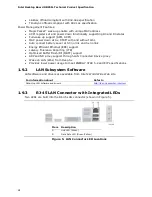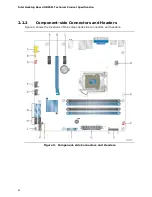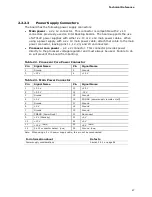
Intel Desktop Board DB85FL Technical Product Specification
34
Table 9. Power States and Targeted System Power
Global States
Sleeping States
Processor
States
Device States
Targeted System
Power
(Note 1)
G0 – working
state
S0 – working
C0 – working
D0 – working
state.
Full power > 30 W
G1 – sleeping
state
S3 – Suspend to
RAM. Context
saved to RAM.
No power
D3 – no power
except for
wake-up logic.
Power < 5 W
(Note 2)
G1 – sleeping
state
S4 – Suspend to
disk. Context
saved to disk.
No power
D3 – no power
except for
wake-up logic.
Power < 5 W
(Note 2)
G2/S5
S5 – Soft off.
Context not saved.
Cold boot is
required.
No power
D3 – no power
except for
wake-up logic.
Power < 5 W
(Note 2)
G3 –
mechanical off
AC power is
disconnected
from the
computer.
No power to the
system.
No power
D3 – no power for
wake-up logic,
except when
provided by
battery or
external source.
No power to the system.
Service can be performed
safely.
Notes:
1.
Total system power is dependent on the system configuration, including add-in boards and peripherals
powered by the system chassis’ power supply.
2.
Dependent on the standby power consumption of wake-up devices used in the system.
1.12.1.2
Wake-up Devices and Events
Table 10 lists the devices or specific events that can wake the computer from specific
states.
Table 10. Wake-up Devices and Events
These devices/events can wake up the computer…
…from this state
Power switch
S3, S4, S5
(
Note 1)
RTC alarm
S3, S4, S5
(Note 1)
LAN
S3, S4, S5
(Notes 1 and 2)
USB
S3
WAKE#
S3, S4, S5
(Note 1)
Notes:
1.
S4 implies operating system support only.
2.
Wake on LAN is only supported from sleep (S3) or hibernate (S4) in Windows 8.
NOTE
The use of these wake-up events from an ACPI state requires an operating system
that provides full ACPI support. In addition, software, drivers, and peripherals must
fully support ACPI wake events.















































